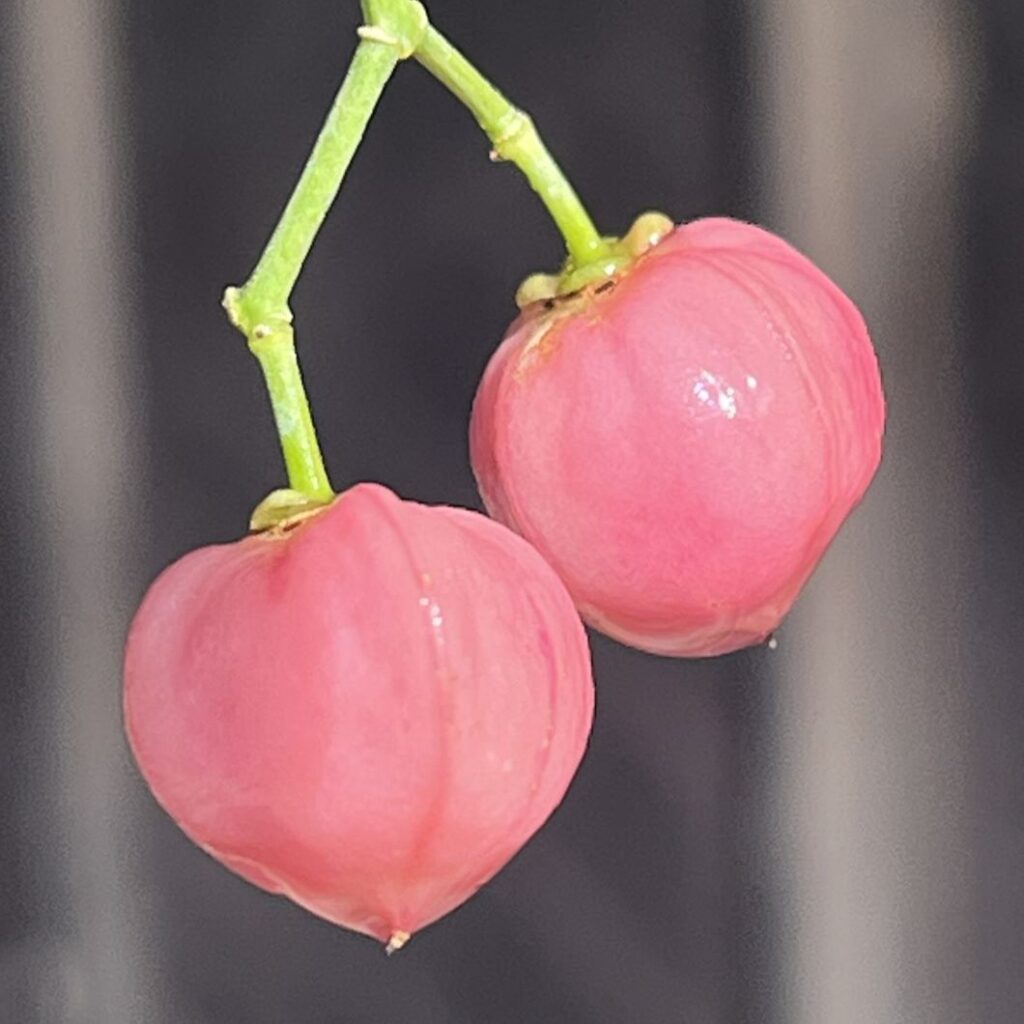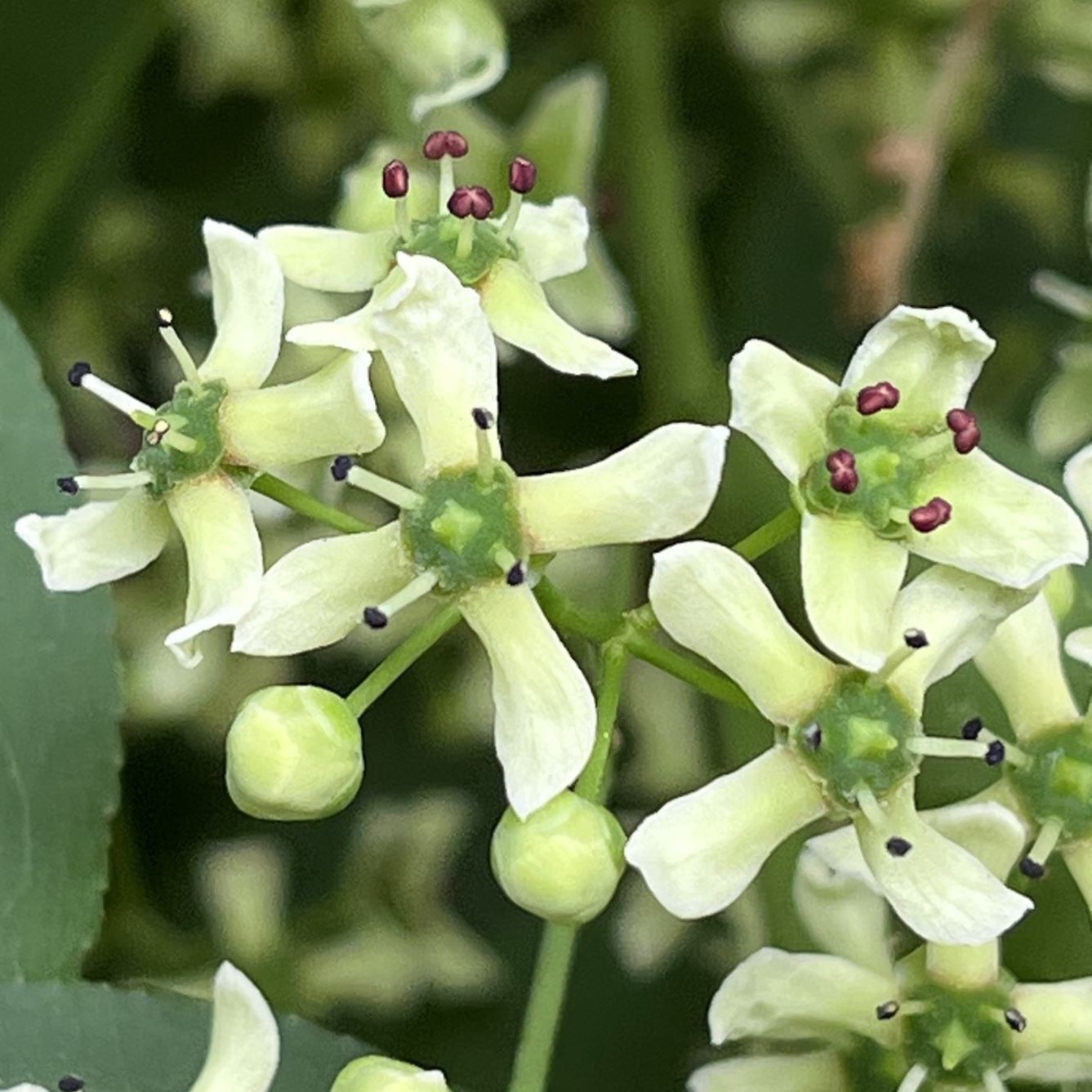マユミは初冬に可愛らしい桃色の果皮が裂け、中から現れる艶やか赤色の種子。一方、初夏に淡い緑色で瑞々しく爽やかな花々を咲かせます。
In early winter, the cute peach-colored skin of the Spindle Tree splits open, revealing shiny red seeds. Meanwhile, in early summer, it produces fresh, refreshing pale green flowers.
【仮名】マユミ
【和名】真弓, 檀
【英名】Spindle Tree, Hamilton’s Spindletree
【学名】Euonymus sieboldianus
【誕生】10/ 31, 11/ 11
【開花】04, 05, 06月
【花色】White, Green
マユミ
マユミの概要

マユミはニシキギ科の落葉小高木。日本では北海道から本州、四国、九州まで、国外では樺太、朝鮮半島、中国、台湾に分布します。初冬に可愛らしい桃色の果皮が裂け、中から現れる艶やか赤色の種子。一方、淡い緑色で目立たないものの、初夏に瑞々しく爽やかな花々を咲かせます。
マユミの名前

マユミの和名は「弓」の美称。強靭な材が弓に用いられたからです。英名スピンドルは「紡錘」という意味。軽く丈夫な材が紡錘に用いられたからです。ラテン語の属名ユオニマスは「評判が良い」という意味。種小名シーボルディアヌスはドイツの博物学者シーボルトへの献名です。
マユミの姿形

マユミの若枝は緑色で緩い4稜。幹の樹皮は灰褐色で、縦に裂け目が入ります。葉は先の尖った楕円形で対生。縁に細かい鋸歯があります。花は雌雄異株で、雌花も雄花も花弁が4枚、雄しべが4本。花後の蒴果は4稜で、熟すと果皮が4裂。中から仮種皮に包まれた種子が現れます。
マユミの利用

マユミの材は緻密で硬く、光沢のある白色。狂いも少ないことから、弓だけでなく、細工物の櫛や印鑑、将棋の駒、こけしなどに加工されました。若芽や若葉はお浸しや天ぷら、和え物などに食用。一方、種子は毒性があり、誤って食べると吐き気や下痢、麻痺などを引き起こします。
Spindle Tree

The Spindle Tree is a deciduous tree of the Celastraceae family. In Japan, it is found from Hokkaido to Honshu, Shikoku, and Kyushu, and overseas, it is found in Sakhalin, the Korean Peninsula, China, and Taiwan. In early winter, the cute peach-colored skin splits open, revealing shiny red seeds. Meanwhile, in early summer, it produces fresh, refreshing pale green flowers.
The Japanese name of the Spindle Tree is a beautiful name for “bow”. This is because its strong wood was used for bows. The English name comes from the fact that its light and durable wood was used for spindles. The Latin genus name Euonymus means “good reputation”. The specific name sieboldianus is a tribute to the German naturalist Philipp Franz Balthasar von Siebold.
The young branches of the Spindle Tree are green and have four loose edges. The bark of the trunk is gray-brown and has vertical fissures. The leaves are oval with pointed tips and grow opposite each other. They have fine sawtooth edges. The flowers are dioecious, and both female and male flowers have four petals and four stamens. The capsule after flowering is four-sided, and when ripe, the skin splits into four. Seeds wrapped in arils appear from inside.
The wood of the Spindle Tree is dense, hard, and glossy white. Because it is less likely to warp, it has been processed into not only bows, but also finely crafted combs, seals, shogi pieces, and kokeshi dolls. Young shoots and leaves are edible in boiled dishes, tempura, and salads. However, the seeds are poisonous and can cause nausea, diarrhea and paralysis if eaten by mistake.



